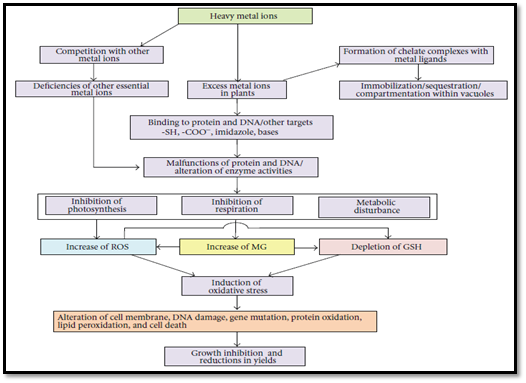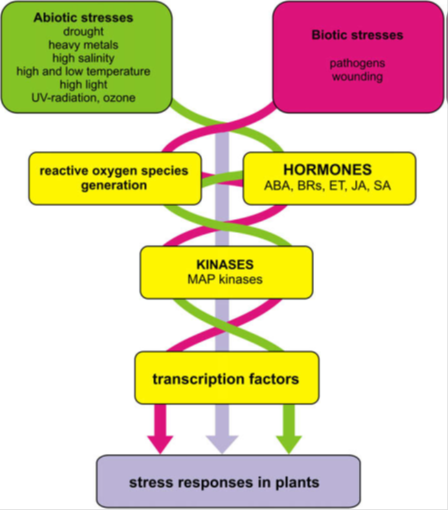Authors: Jalpesh S. Patel*1 and Ankit Patel2
1 Department of Biochemistry, Anand Agricultural University
2Department of Agril Microbiology, Anand Agricultural University
*Email: jalpeshpatel.2729@yahoo.com
Introduction
Abiotic and biotic stresses adversely affects on plant growth, development and productivity. Abiotic stress is classified into temperature, water, oxidative and salinity stress. Among which oxidative stress cause mainly due to nutrient deficiency or accumulation of heavy metals. "A heavy metal is a metallic element which is toxic and has a high density, specific gravity or atomic weight with a potential negative health effect or environmental impact".
Heavy Metals: Nutrients or Toxic Elements?
Plants acquire mineral elements from soil primarily in the form of inorganic ions. Plant absorbs toxic non-essential elements (Cd, Pb, Cr, Hg, As, Co, Al) and essential nutrient elements (macronutrients: N, P, K, Ca, Mg, S and micronutrients: Ni, Cu, Zn, Mn, Fe). Micronutrient requirement of plant is very low as cofactors of enzymes.
Heavy metals accumulated in soil and water due to human activities like mining, smelting, industrial waste, vehicle emission, use of fuels and explosives, electroplating, leather processing and finishing, manufacture of special chemicals and cleaning agents (Dalcorso, 2012). The accumulation of certain heavy metals in soil or sewage water cause the negative effect on plant growth and productivity.
Negative Effect of Metals on Plant
Imbalances water and nutrient uptake, interfering with the absorption of Ca, Mg, K, P, Mn, Zn, Cu and Fe, Inhibits root growth and lateral root formation, damages the photosynthetic apparatus, disturbed the thylakoid membrane, inhibits enzymes involve in chlorophyll biosynthesis and enzymes of calvin cycle, alter gene expression and calcium dependent signaling, leading to the accumulation of ROS by inducing imbalance in the activity of antioxidant enzymes (Vazquez et al., 2013).
Negative effect of Reactive oxygen species
ROS are continuously produced at low level during normal metabolic processes, but in biological systems excess production of ROS inhibit water channel and transporter proteins, enhancing lipid peroxidation, alters membrane fluidity, stability and structure, inhibiting membrane dependent processes such as electron flow in chloroplast and mitochondria and damage nucleic acids and proteins.
Toxicity Mechanisms of Heavy Metals
Induction of oxidative stress and changes in the cell membrane permeability and integrity, reaction with sulfhydryl groups (â€"SH), similarity to biochemical functional groups e.g. AsO4-3 & PO4-3, displacement of essential (cat)ionic cofactors in enzymes and signalling components (Dalcorso, 2012).

Fig.1: Biochemical and molecular mechanisms of heavy metal mediated ROS induction and damage in higher plants (Hossain et al., 2012).
Plant response to Heavy metal toxicity
Plant reducing uptake and translocation of heavy metals, detoxification by chelation, activate signal transduction pathway by hormones or activate oxidative stress defence mechanism by increasing activity of antioxidant enzymes and concentration of non enzymatic antioxidants. Hormones like auxins, abscisic acid (ABA) and Brassinosteroids have been recently found to work as vital components of stress management (Vazquez et al., 2013).

Fig.2: Generalized model of the plant stress signalling networks. ABA, abscisic acid;BRs, brassinosteroids; ET, ethylene; JA, jasmonic acid; SA, salicylic acid (Bajguz and Hayat, 2009)
Brassinosteroids (BRs)
Mitchell in 1970 first time extracted from rape pollen and Grove in 1979 identified as brassinolide. BRs are a class of polyhydroxy steroids, sixth class of plant hormones, occur in free form and conjugated to sugars and fatty acids. Brassinolide, 24-epibrassinolide and 28-homobrassinolide are the three biologically active and being widely used in studies (Rao et al., 2002).
Biosynthesis of Brassinosteroids
Brassinolide synthesised from mevalonic acid via 24-methelene cholesterol, campestanol to brassinolide (Choe 2006). Active BR signalling regulates the expression of BR target genes that are involved in the induction of antioxidant systems and metabolites that protect nucleic acids, proteins and cell membranes and improve stress tolerance. Active BR signalling can induce gene expression of NADPH oxidase to regulate H2O2 production and upregulate nitric oxide production, which promotes ABA biosynthesis, resulting in stress tolerance.
Role of Brassinosteroids in plants
The 24-Epibrassinolide detoxify the stress generated by CdCl2 and significantly improve growth, the level of pigment parameters, green pod yield, membrane stability index, level of proline and activity of antioxidant enzymes which were reduced due to CdCl2 (Rady 2011). Similar results were recorded by Anuradha and Rao (2011) in Pb treated radish plant. They also observed that the photosynthetic rate, activities of nitrate reductase and glutathione reductase reduced under presence of Pb and increased on the exogenous application of brassinolide. EBR also ameliorates Cr(VI) stress via influencing the levels of IAA, ABA, polyamines and antioxidant system of Radish seedlings by enhancing level of polyamines, IAA, ABA, ascorbic acid, glycine betaine and proline even in the presence of Cr and decrease the content of malondialdehyde and H2O2 (Choudhary et al., 2011). Xia et al., (2009) have already reported that BRs promote photosynthesis and growth by enhancing activation of Rubisco and expression of photosynthetic genes in Cucumis sativus. BR increased photosynthesis, through regulating the expression of genes for the Rubisco subunits and other Calvin cycle enzymes.
Conclusion
BRs help to regulate the uptake of ions and reduce the uptake of heavy metals. Application of BRs improves plant growth and resistance against heavy metal stress. Stimulate the synthesis of some antioxidants such as proline, glutathione, ascorbic acid, glycine betaine and phytochelatins. Increase the activities of antioxidant enzymes like catalase, peroxidase, SOD, APOX and GPOX. Decrease the production of ROS and prevent the cell from damage. Cause the induction of other growth promoting hormones. BRs are environment-friendly suitable for yield promotion when soil is contaminated by heavy metals.
References:
1. Anuradha S and Rao S. 2011. Amelioration of Lead Toxicity in Radish (Raphanus sativus L) Plants by Brassinolide. Journal of Applied Biological Sciences. 5(3): 43-48.
2. Bajguz A and Hayat S. 2009. Effects of brassinosteroids on the plant responses to environmental stresses Plant Physiology and Biochemistry. 47:1â€"8.
3. Choe S. 2006. Brassinosteroid biosynthesis and inactivation. Physiologia Plantarum. 126:539â€"548.
4. Choudhary S, Kanwar M and Bhardwaj R. 2011. Epibrassinolide ameliorates Cr (VI) stress via influencing the levels of indole-3-acetic acid, abscisic acid, polyamines and antioxidant system of radish seedlings. Chemosphere. 84:592â€"600.
5. Dalcorso G. 2012. Plants and Heavy Metals, SpringerBriefs in Biometals. pp: 1-26.
6. Hai-hua W, Tao F and Xi-xu P. 2009. Ameliorative Effects of Brassinosteroid on Excess Manganese-Induced Oxidative Stress in Zea mays L. Leaves. Agricultural Sciences in China. 8(9):1063-1074.
7. Hossain MA, Piyatida P, Teixeira da Silva JA and Fujita M. 2012. MolecularMechanism of HeavyMetal Toxicity and Tolerance in Plants: Central Role of Glutathione in Detoxification of Reactive Oxygen Species andMethylglyoxal and in HeavyMetal Chelation Journal of Botany. Article ID 872875, 1-37.
8. Rady MM. 2011. Effect of 24-epibrassinolide on growth, yield, antioxidant system and cadmium content of bean (Phaseolus vulgaris L.) plants under salinity and cadmium stress Scientia Horticulturae. 129:232â€"237.
9. Rao SS, Sujatha E and Anuradha S. 2002. Brassinosteroids â€" New class of phytohormones. Current Science. 82:1239-1245.
10. Vazquez MN, Guerrero YR, Gonzalez LM and Noval WT. 2013. Brassinosteroids and Plant Responses to Heavy Metal Stress. An Overview. Open Journal of Metal. 3:34-41.
11. Xia XJ, Huang LF, Zhou YH, Mao WH, Shi K, Wu JX, Asami T, Chen Z and Yu JQ. 2009. Brassinosteroids promote photosynthesis and growth by enhancing activation of Rubisco and expression of photosynthetic genes in Cucumis sativus. Planta. 230:1185â€"1196.
12. Yusuf M, Farididdin Q and Ahmad A. 2012. 24-Epibrassinolide modulates growth, nodulation, antioxidant system, and osmolyte in tolerant and sensitive varieties of Vigna radiata under different levels of nickel: A shotgun approach. Plant Physiology and Biochemistry. 57:143-153.
About Author / Additional Info:
I am a Ph.D. scholar in Biochemistry with Inspire fellowship